6 Metre Pre-Worlds a preamble to the 2025 Worlds
By Tom Darling, Conversations with Classic Boats
Photos by Peter D. Taylor
When I heard that an iconic meter boat collection was coming to Oyster Bay, New York, the historical hub of 6 Metre sailing in the U.S., I was all ears.
Earlier articles about on the development and growth of the International Six Meter (Metre) yacht appeared on these pages in 2021 and ’23; online at windcheckmagazine.com/article/a-century-of-sixes/ and windcheckmagazine.com/article/sixes-in-seattle-the-search-for-the-lost-fleet/. It was a story of emerging designers, well-heeled and innovative yachtsmen, and staunch international competition between the U.S. and Europe. Some names you know: Clinton Crane, Olin Stephens, Herman Whiton.
The Golden Age of the Sixes, which started in 1921 with the start of the British American Cup, abruptly ended in 1937 with the relentless movement of Europe to war. The Six Meter last appeared in the Olympics in the 1952 Helsinki Games, subsequently replaced by a modern derivative of the Six called the 5.5 Meter. The rise of international keelboat classes like the Soling and Etchells 22 further eroded the attraction of graceful but expensive traditional meter boats, 6s and 8s in particular.
Essentially, the Six Meter class went into hiding. Pockets of fleets remained on the West Coast of North America in Seattle, Vancouver and to a limited extent, San Francisco. But the International Six Metre circuit that had schooled so many famous helmsmen in the Northeast was no more. The class was moribund.
Move ahead a generation to the 1970s and a new group of designers became interested in the Six. This was partly because the Americas’ Cup advanced the Six Metre’s role as a testbed for 12 Metre designs. New names like Pelle Petterson in Sweden, Ian Howlett in the UK and Gary Mull in the U.S. were developing modern models with complex keels, new hull shapes, and powerful masthead rigs with maximum-sized genoas. They raced alongside the so-called “Classic” or vintage boats while scoring among their fellow modern boats. Their benchmark was the traditional designs of Sixes like those of Olin Stephens with boats like Fun, Goose and Llanoria. These were the top shelf designs of the 1930s and ‘40s.
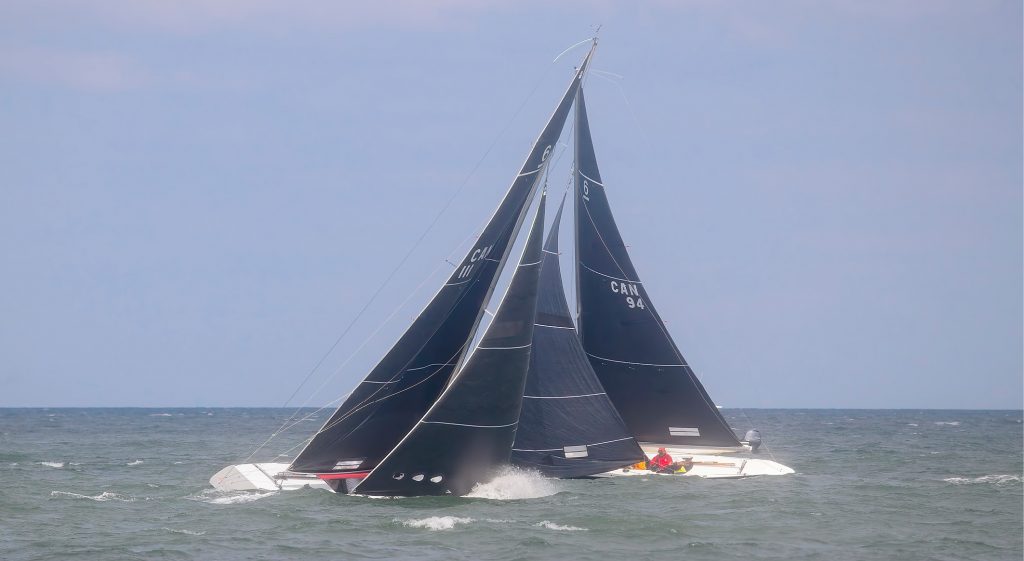
Rainer Muller brought seven 6 Metres from Europe to the Pre-Worlds event off Oyster Bay. The goal? A Worlds in 2025. Pictured are Blade (CAN 111; left), skippered by Peter Wealick, and Pre-Worlds winner Wild Cat (CAN 94), with Dave Cross helming. © Peter D. Taylor
Metre Boat True Believers: From 12s to 6s
A handful of individuals remained true believers in the future of International Metre boats. Obviously, the 12 Metre was the weapon of choice for the America’s Cup matches until 1983. After Australia II’s Newport upset, an inventory of 12s grew around the world, appearing in events alongside the classic pre-America’s Cup 12s like Starling Burgess’ Onawa or Clinton Crane’s Gleam.
Ironically there are more 12s sailing today than ever, and with younger and younger crews. In 2024, a crew of young Oakcliff sailors came up to Newport to master the most famous modern 12, Courageous. In Classic Yacht Owners Association events, the 12s come to Nantucket’s Opera House Cup or Newport’s Labor Day event. In Newport, where more than a dozen 12s are housed in a foundation to permit efficient upkeep, that is where the most 12s come out to play.
But the 6 Metre has been in many ways the forgotten child in the US. Two individuals, one in Seattle and one bicontinental – shuttling between Vancouver, BC and Northeast Switzerland – carry the torch of the International Six.
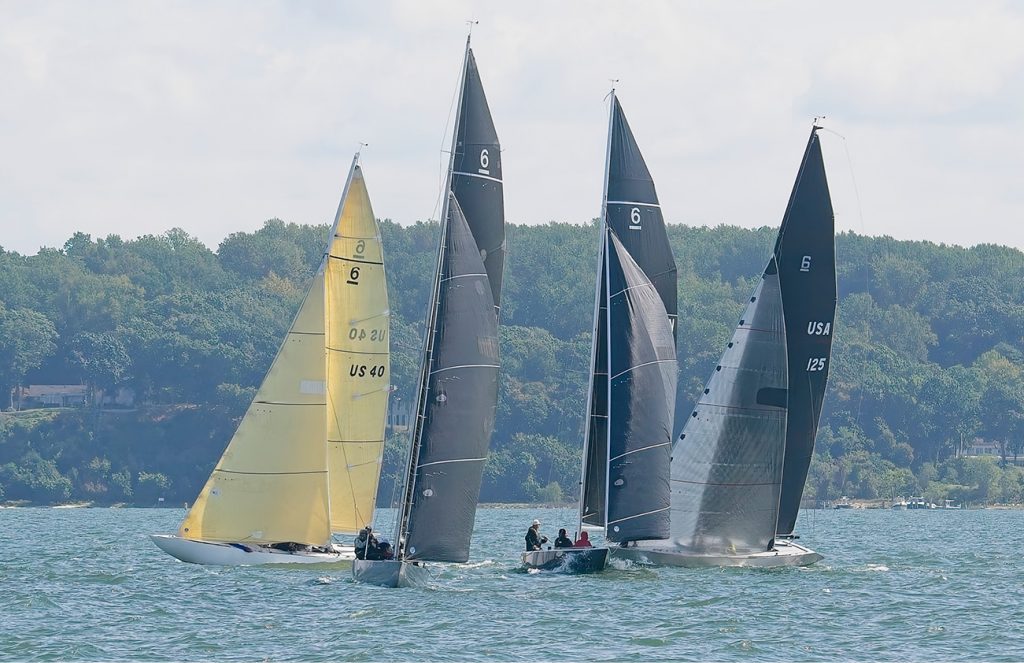
At the pre-start, Saleema (US 40; left), skippered by Willets Meyer and launched in 1928, contrasts with the black-sailed designs of the last 50 years. © Peter D. Taylor
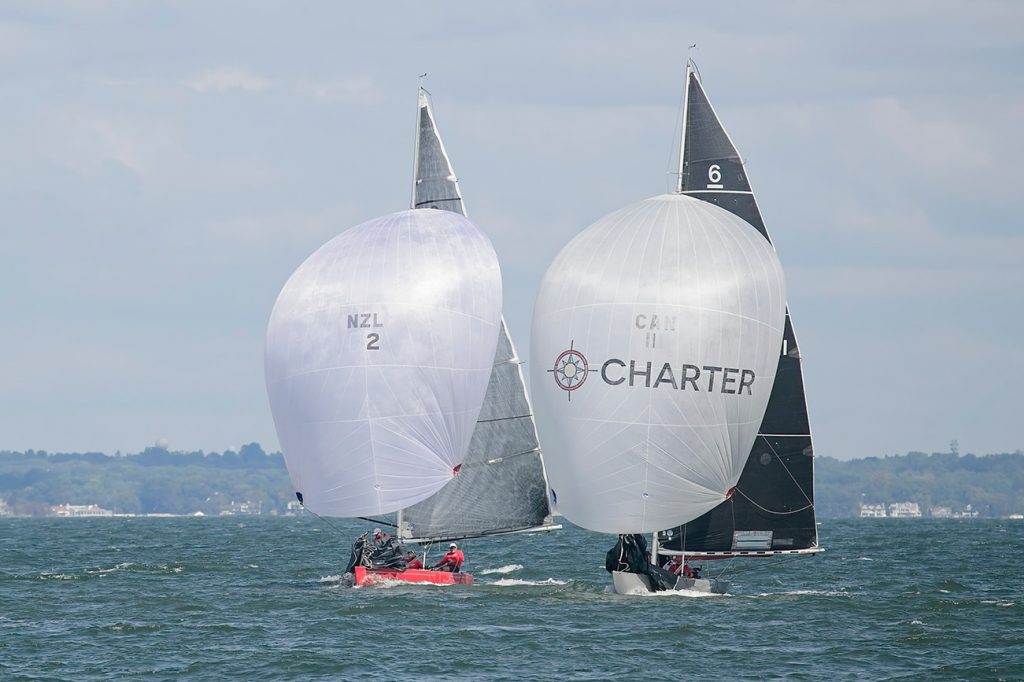
The big symmetrical kites flown on Sixes derive from tall rigs and big spinnaker poles. © Peter D. Taylor
A Passion for the Iconic Six
The first, Peter Hofmann, is following in his father’s footsteps collecting the classics (like the famous US- 81 Goose) and the castoffs. Hofmann’s father once bought eight 6 Metres for $2,500, the calculated value of the lead in the boats’ keels.
Peter traces his interest in restoring a Six back to a design for the first Olympics where sailing was included. In his Bainbridge Island shed is Diamante. An entrant for those 1906 Games, she is waiting for the means to restore her.
Meanwhile, in Europe where the Six Metre has a stronger following, in lakes and calm coastal racing, there is a lone individual who has taken on the Six as a case study of how to buy, build and maintain a fleet of complex meter boats.
His name is Rainer Muller, Swiss-German born with a well-worn passport to North America. Muller has spent the last fifteen years putting the spotlight on the 6 Metre while he assembles a collection of boats worthy of Antiques Roadshow.
“I am a Sixer,” says Muller. He is a devoted connoisseur of 6s and collector of a dozen sailable boats in the U.S, a dozen in Europe, and group in between under repair, a total of thirty boats he figures. A dozen reside on Lake Constance, bordering three countries (Switzerland, Germany and Austria) among an active inland keelboat scene.
Hofmann and Muller came together at the 2009 6 Metre Worlds in Newport, the last Worlds held in North America. Out of that event remerged a partnership between the two, the common asset being Llanoria, the Olympic Gold Medal winner in 1952, the last year that Sixes appeared in the Games. That partnership became the base for a worldwide Sixes network, in which Hofman’s boatyard near the Port Madison Yacht Club on Bainbridge Island across the water from downtown Seattle, became the western hub for “Team Sixes.”
Sixes In Seattle
Peter Hofmann has been around Sixes for fifty years. In his native Seattle in the 1960s into the ‘70s, a fleet of up to twenty boats sailed out of the Shilshole Marina north of Seattle. But owners aged out and boats languished. Values declined to the point that Peter’s father was buying boats for the scrap value of the lead.
Hofmann looked to the revival of two of the greatest Sixes ever built, by Henry B. Nevins in City Island, New York. It was Goose, launched in 1938, that re-ignited his interest. Goose was built by Nevins to a Sparkman & Stephens design and had the dubious distinction of having her transom sawed off and mounted on the wall of the dining room of the Seawanhaka Corinthian Yacht Club.
With a new rear end, Goose was especially slippery and fast in Long Island Sound’s light airs. Goose, to my eye, always looked like the prototype for Olin Stephens’ 1964 Cup defender Constellation, the last traditional hull shape before Intrepid introduced the radical fin keel/spade rudder configuration to Cup racing.
Llanoria came next from S&S, in 1948, intended for the London Olympics, which she won. She was the commission of Herman Whiton, an extraordinary Six aficionado who would become the patron of the National Sailing Center in Miami. “Goose, Llanoria…they were similar boats, just ten years apart,” said Hofmann.
It was Llanoria, named for a Texas oil deposit, that figured in the Hofmann’s bonding with a zealous meter boat collector in Switzerland to create a bi-continental collection of the International Six Metre.
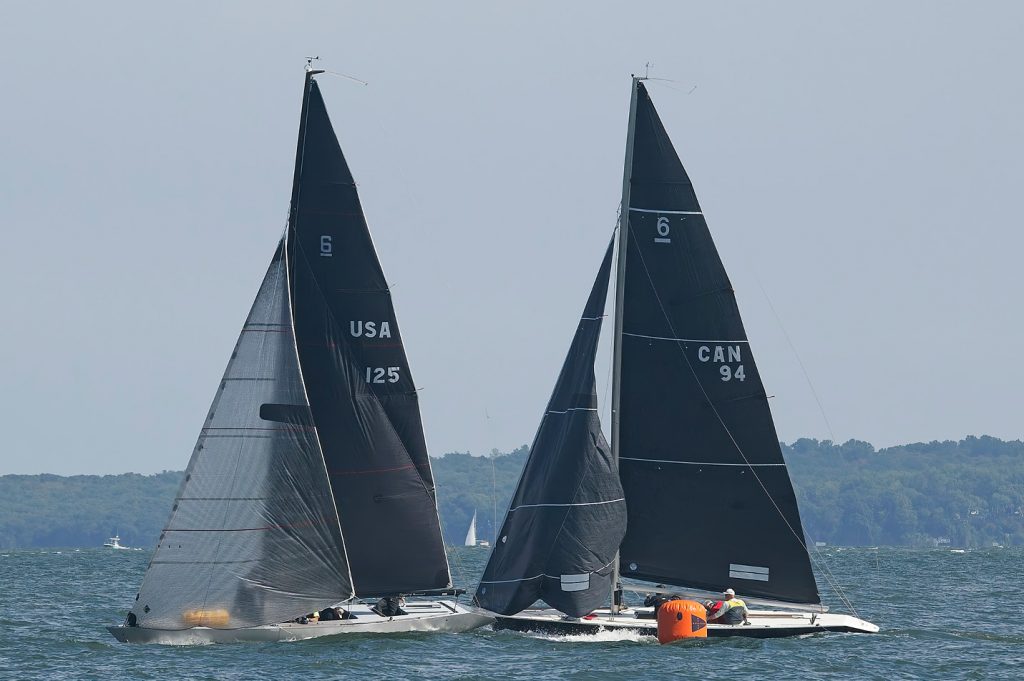
Tempest (USA 125; left), skippered by Brian Tait, leads Wild Cat around a mark. Tempest finished second overall, a single point astern of Wild Cat. © Peter D. Taylor
Part of the interest for Rainer Muller was the presence of the most famous pair of designs of the mid-20th century, Goose and Llanoria. For Muller, there was always a certain logic to trading in Six Metres. In Europe, where the boats were plentiful, the 6 was the bargain boat, available for 60-70,000 euros while a modern 5.5 Metre could cost up to 250,000 euros. He saw a Six Metre as the sum of its parts, any one of which he could modify:
First, the hull, typically the same weight boat-to-boat for a long, narrow hull, at 2000 pounds. Second, the keel, massive, two-and-a-half times the hull weight and considered to have the most potential to enhance performance with configurations of wings and appendages.
And finally, the rig, including sails that cost up to $40,000 for a new suit. It is the art of choosing and buying used sail inventory that is the most important cost management technique. Muller makes a market in used sails and spreads them around his boats.
The Lego game that is assembling these parts of a Six Metre has always been the same. To push on one parameter, you must change another. Shorten the waterline, add more sail. Change the size and configuration of the keel, change the hull and the sail plan. A Six is a designer’s dream and an owner’s bag of compromise.
The key letter, says Hofmann, is “J.” That averages 10 feet, 6 inches for a Six. Go longer and your genoas get bigger and your spinnaker pole longer. Another dimension must change. A Six is a Rubik’s Cube of a 36-foot boat. That’s the world of a rule-based design.
Rainer Muller seems to revel in it. He is a real estate entrepreneur, building retirement residences and living primarily in Vancouver. From his Swiss background, he kept strong ties to Switzerland where had been sailing in the active keelboat scene on Lake Constance. A glance online shows Lake Constance to be at the junction of Germany, Switzerland and Austria. Fleets of meter boats including Sixes and the 5.5 Metres are the active classes. Owners are aggressive. They build new boats, shed them and build another.
Muller fell in love with the Six Metre design and jumped in feet first to acquire the best models he could find in the European fleet. The Six Metre Class Association has an historian based in the UK who tracks the 160-odd boats known to be sailable in Europe and the U.S. (6metrearchive.org). By my count, more than 100 sixes have a European homeport.
Muller began collecting with a vengeance. His purpose was clear: find and buy the best Sixes, at an attractive price of course, and have his own private fleet. Think of his fleet as a private horse racing stable or a garage full of vintage grand prix Bugattis, Alfa Romeos and Delages.
Before he knew it, Muller had the title to twenty European 6 Metres. His modus operandi was unusual. He owned the boats, he maintained them, he inventoried used sails to rig them, and offered them to interested users. His motive was class development. How could a sailor resist if offered a “Rainer 6” to sail?
In addition to Hofmann and Muller, there is a group of unique characters among the 6 Metre sailors here in North America. One Vancouver skipper, Peter Wealick, is a member of the Sto:lo First Nation and was the first indigenous person to serve as Commodore of the 121-year-old Royal Vancouver Yacht Club. The owner of Aboriginal Computer Solutions, a firm dedicated to providing computing to aboriginal communities, he’s been a trailblazer in international sailing competition. When he is not working in his computer service business, he’s sailing an orange 6 Metre. The name, Max’Inux, we translate as “Orca.”
The Pre-Worlds for September 2025: How to Build a Regatta
This past September, Muller underwrote the shipment and commissioning of seven boats in his fleet for the purposes of demonstrating in a “Pre-Worlds” in Oyster Bay that a World Championship in Long Island Sound was viable. There were concerns about an absence of wind and the dock facilities to which European racers are accustomed.
Muller brought his boats and recruited the crews to do his real time demonstration. With a Seawanhaka Corinthian Yacht Club race committee running the show, the Pre-Worlds was an inspiring three days of fall sailing.
Event photos from Peter Taylor depict the history of a class over 100 years old. The fleet of nine boats varied in age from Hugh Jones’s Madcap (SCYC), intended to be a contestant for the 1923 British American Cup, to late ‘70s and ‘80s modern designs of Britain’s Ian Howlett and Sweden’s Pelle Petterson. They all hearken back to the legendary Sixes of Olin Stephens, often trial horses for his 12 Metre designs.
Peter’s images show the grace and power of these (on average) 36-footers sailing in a choppy easterly outside Oyster Bay. Normally, the high end for wind speed for sailing these boats is 20 knots. The big genoas and overall sail plans, along with relatively low freeboard, set a practical limit below that. In European lakes and coastal waters, this velocity is rarely exceeded.
The Europeans and the locals alike were pleasantly surprised that the Dead Sea (aka Long Island Sound) served up some real wind. This past September’s contestants were working hard in the current-induced lump to keep the boats dry and moving. They reveled on brisk downwind legs with their J-length spinnaker poles and big shouldered chutes. What was the overall sailors’ assessment of the event as qualification for a 2025 Worlds in Long Island Sound? Wind and water both checked the box.
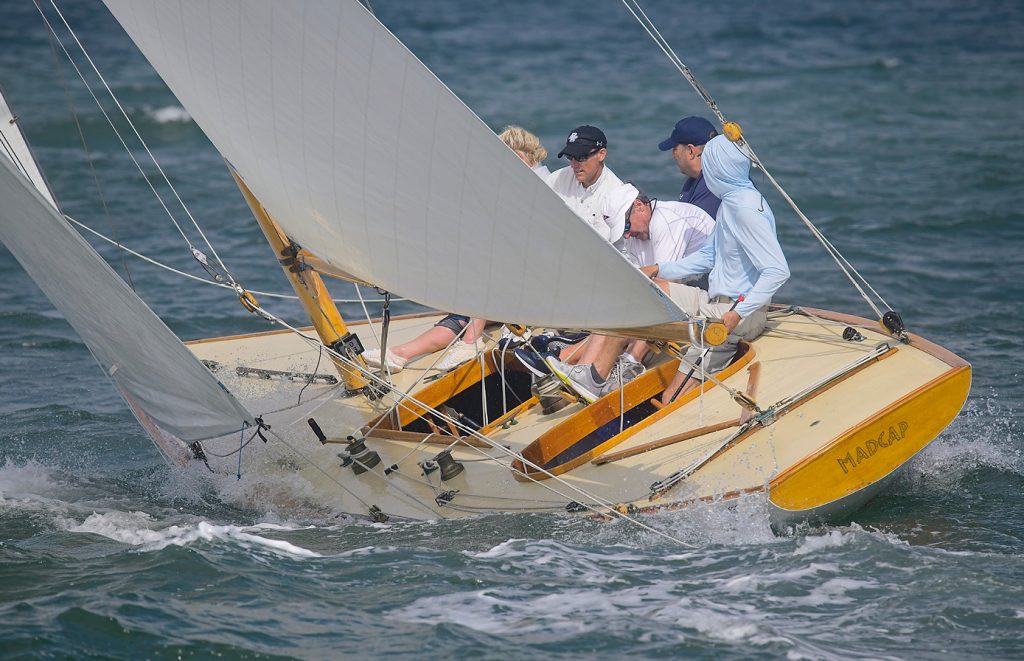
Madcap, an early 1920s design co-skippered by Hugh Jones and Russell Byers, is competitive with modern Sixes in the right conditions. © Peter D. Taylor
Most of us in our best Walter Mitty reverie could see ourselves at the helm of a Six Metre. Life for the skipper looks grand, not so much for a crew. Crew amenities are minimal. The four-person crews are clustered into pits cut into the deck like foxholes. Downwind, only the foredeck crew was in plain sight. Drysuits appear to be necessary for trimmers, as the water washes over everything. A good bilge pump and a well charged battery are urgent necessities.
But upwind and downwind, sailing a Six is exhilarating. She’s like a Formula One car on water. You are sailing half a 12 Metre, thrilling and exacting, and a bit of classic yachting heritage.
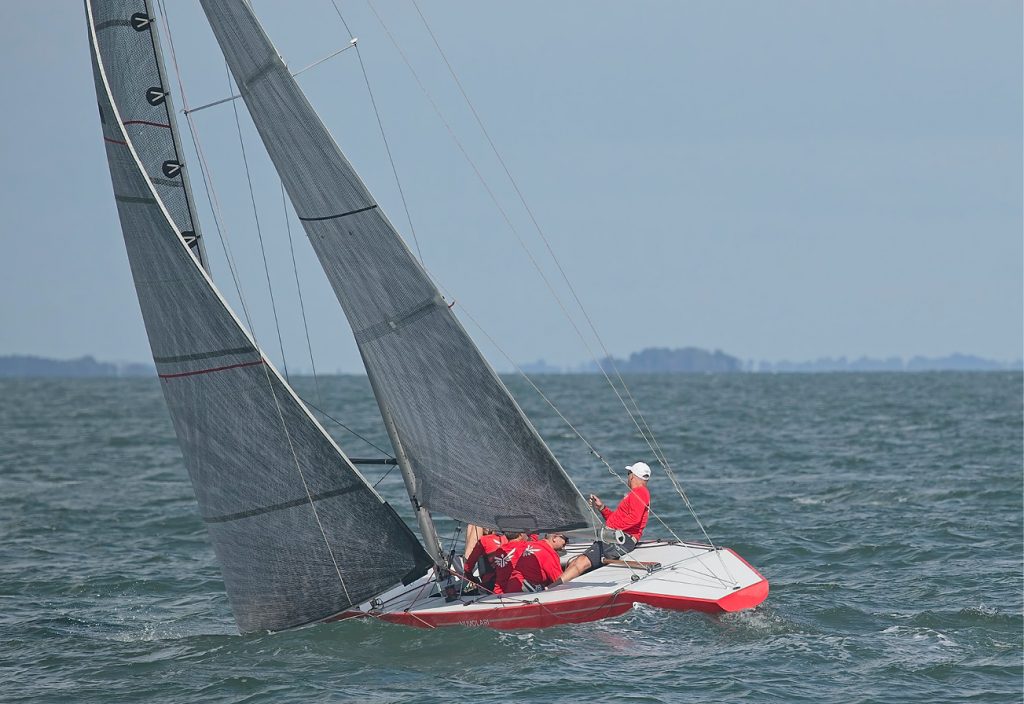
Co-skippered by Tina & JP Blaise to third place, Nuvolari (fittingly painted Italian rosso corse) is named after one of the all-time greatest racing drivers. © Peter D. Taylor
The 2025 Worlds
The path to a September 2025 Worlds will be winding. Rainer Muller is willing to bring in his Euro fleet, up to fifteen boats, and recruit U.S. crews. That offer would be hard to turn down.
Bringing the American boats from Seattle is a more difficult and expensive process. It costs $10,000 to transport in a custom container from Seattle to Oyster Bay. Peter Hofmann is a boat restorer on a homebuilt budget. His fleet, sitting at Port Madison Yacht Club on Bainbridge Island adjoining Puget Sound, including the prized, impeccably restored Goose and Llanoria, has a punch list of needed improvements.
The question for all new regattas, even a Worlds, is recruiting participants and funding the event. In Europe, sailing is a commercially attractive, sponsorable sport. Advertisers from liquor companies and car companies to financial services firms like the upscale association with luxury sailing. We will watch with interest and hope we can get a ride come September 2025.
In 1906, the Six Meter debuted in the Paris Olympics. We hope the international Six Metre community returns to the cradle of American
Six Metre racing, Oyster Bay, in 2025. If you have questions, reach Peter Hofmann at yachtrig@comcast.net. ■
Not a formally trained historian nevertheless a boat storyteller, collecting and reciting stories for the boating curious, Tom Darling hosts Conversations with Classic Boats, “the podcast that talks to boats.” Tune in via Apple Podcast, Google Podcast or Spotify, or online at conversationswithclassicboats.com.



